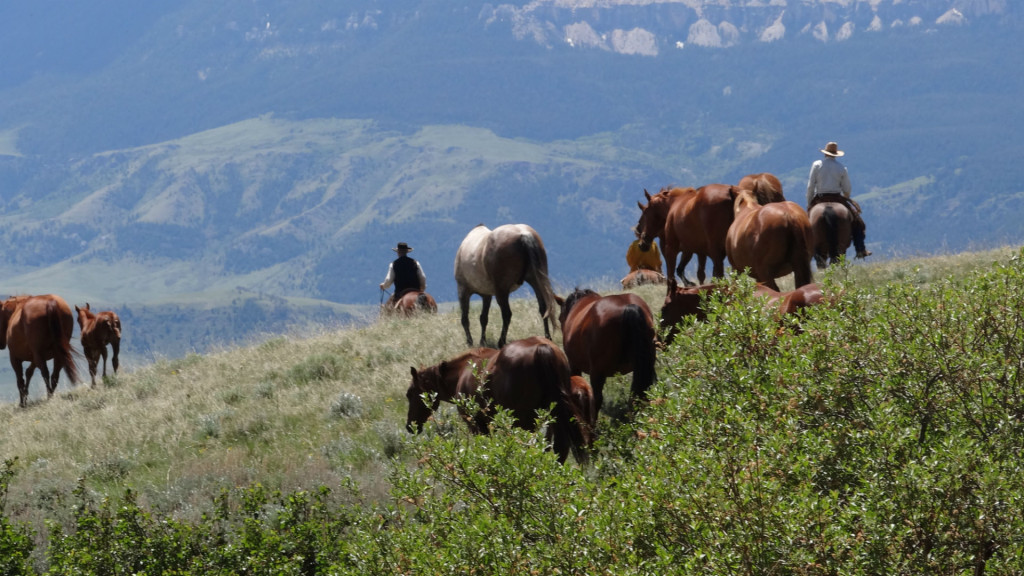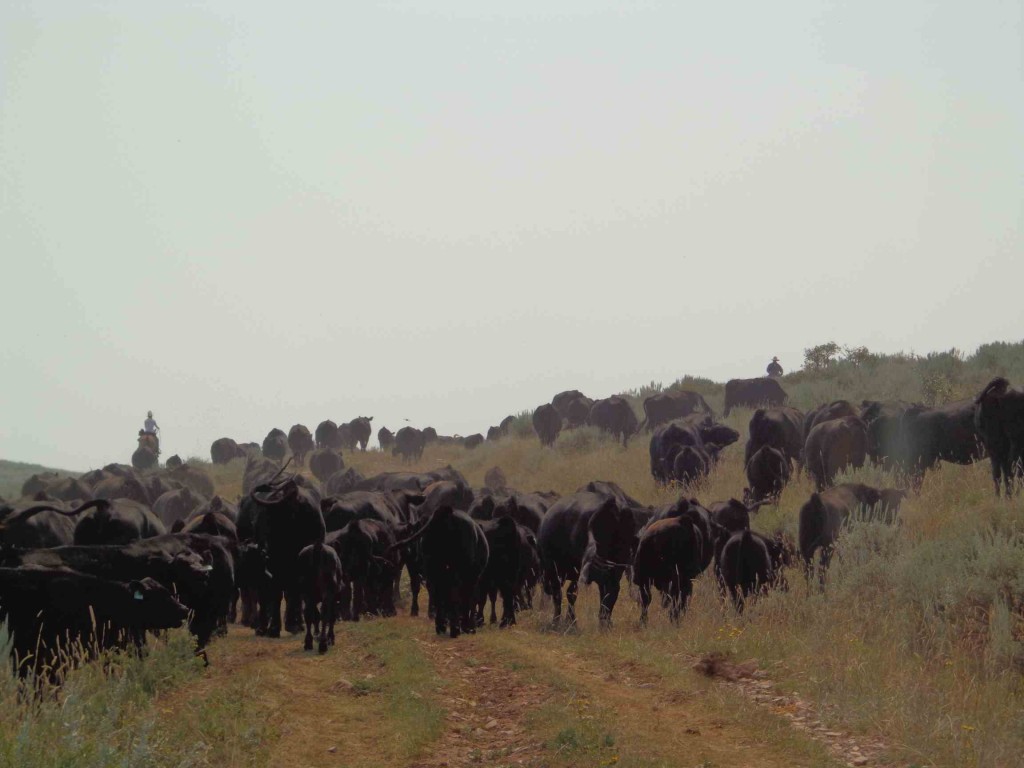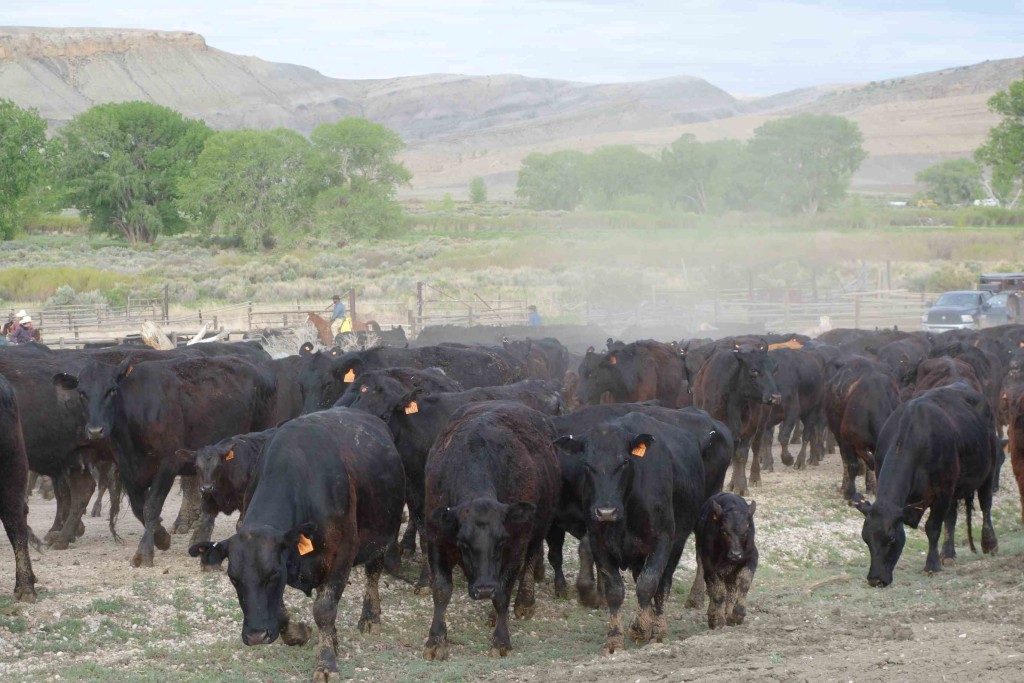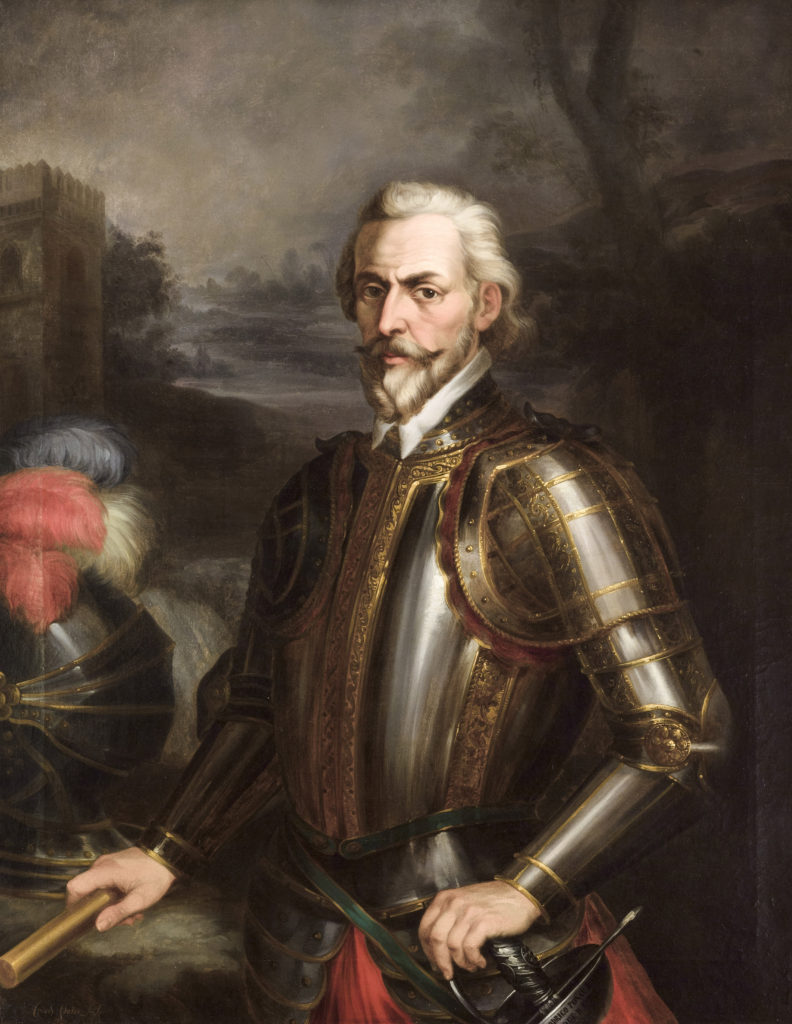
The History of Cattle Drive Vacations in Montana
For a truly unique cattle drive vacation, Dryhead Ranch offers a functioning modern day working cattle and horse ranch which lets you dive into the Wild West. Unlike so many other working ranches in this day and age, we primarily use horses to tend to our herds and maintain our land. In doing so, we are seeking to maintain the great American tradition of working ranches and cattle drives.

Wyoming and Montana have long been associated with cattle and cowboys. Often, when you ask a person what they think of when you mention these states, Old West imagery of saddles and spurs are at the top of the list. Of course, some people might think the same thing about Texas or Nevada. As time has moved on, much of the West has given up on the traditional life-ways which give rise to the region more than 150 years ago. This is not the case at Dryhead Ranch. Driving cattle in the footsteps of the first intrepid pioneers, we continue to cultivate the skills and culture that made the West great.
We offer the unique opportunity for others to share cattle ranch life by cattle driving alongside our modern-day cowboys and cowgirls. The history of driving cattle has helped shape the United States into what it is today and we seek to carry that into future generations.
Tradition of Cattle Drives
The tradition of working cattle drives began well before the United States had officially formed. Settlers began driving cattle all over North America as early as 1540. As the population in what is now the United States began to grow so did the demand for beef.
Though the nascent beef industry grew slowly and steadily throughout the first part of the nineteenth century, it wasn’t until three major events changed the face of food production that beef really took off in the United States. The first was the Civil War. The most devastating conflict in American history, the Civil War pitted brother against brother in a complex conflict which called into question the very foundations of the Republic. Its long, meandering fronts demanded constant shipments of vittles from the hinterlands, and just such a hinterlands existed in Montana at the time. The second event that moved beef faster and more efficiently than ever before came in the form of the railroad. Never in the history of mankind had we been able to move people and goods faster than a horse could run. With the railroad, moving at a great speed was now possible, and with massive cargos to boot. Among these cargos going to the fronts were products of the third great event that changed the beef industry forerever: industrial canning. Before the advent of industrial canning, beef manufacturers would have to drive their cattle all the way to market. Pre-processing was simply impossible, as the meat would have to be kept on ice for long distances… something that was just not feasible in the second half of the nineteenth century. Industrialized canning meant that both army rations and market faire could be produced en masse at a factory, canned, and then shipped without having to worry about the logistical challenges of feeding and transporting live animals.
These three events changed the face of the beef industry and the West permanently. In the years immediately following the Civil War, the Montana beef industry exploded. Ranchers who used to struggle from year to year were becoming millionaires. Though beef consumption is down since the late 1900s, the effects of this beef boom can still be seen throughout the West.
Early ranchers and cowboys would drive their cattle from one location to another, often spanning hundreds of miles, for the purpose of selling their cattle for the best price. Often the demand would fluctuate and one location such as what is now Kansas or Colorado would offer a greater price per head. The demand for beef would also change as it was at the mercy of society’s preference. As supply and demand shifted so would the destination of the cattle drives. They went wherever they could receive the most amount of money for their herd.
Smaller cattle drives were necessary for ranchers as they tended their herd. As the cattle resided in one area the grass they rely on for food would diminish as they grazed the land. It was then necessary to move the herd to new pasture in order to ensure that they were properly nourished. These working cattle drives were much shorter. Instead of crossing great expanses the cows would remain located on the ranchers own land. Crossing acres gradually as they grazed the land instead of hundreds of miles they would later travel for the purpose of selling the herd.
Looking for a Real Cattle Drive Holiday?

At Dryhead Ranch we welcome guests on your cattle drive holiday in order to share in the age old American tradition of driving cattle. You will join us in moving our herd from where they winter in Lovell, Wyoming to our home on Dryhead Ranch. The journey spans 50 miles and will give you the opportunity to see the beautiful countryside while becoming an honorary Dryhead ranch hand. The hard work and team building necessary for cattle driving will serve to draw your family closer together while providing you with the thrill of a lifetime. These cattle drive vacations are ideal for the family man and adventurer alike.
It’s time to plan your cattle drive vacation. Join us at Dryhead Ranch and become a new member of our family. Work alongside us as we carry on the American tradition of working ranches and cattle drives. When you sign up for one of our cattle drives you aren’t simply watching us work but partaking in the adventures of working ranch life. You become one of our family and work alongside us as we care for our cattle and horses. Sign up for one of our cattle drives today and join us in celebrating the American cattle ranch tradition.
Cows might be the most important part of cattle drive vacations. Where do cows come from? How were they domesticated? These are questions that set the stage for a cattle drive holiday in Montana. Knowing the history of cows helps you understand why the cattle drive tradition has remained strong to this day. Though much has changed since the beginning of cattle domestication, the unique relationship between humans and cows has stayed largely the same. When you book your cattle drive vacation, you are taking your own step into a long line of cowherds before you.

Cattle Drive Vacations History
The first cows were domesticated from the wild aurochs of southern Europe and southwestern Asia thousands of years ago. Exactly how this happened is an object of hot debate. Most archaeologists agree that wild aurochs were domesticated at least twice, leading to the two predominant types of domestic cattle we encounter today: humpless (or “taurine”) cattle and humped (or “indicine”) cattle. These separate domestication events occurred independently from one another, thousands of miles apart.
Bos taurus Domesticated in Turkey
The most diverse cattle region on earth is found near the Taurus Mountains in southern Turkey. Biologists who study domestication say genetic diversity is a key indicator of an original population of domesticated animals. This is because, as small groups of a domesticated animal (in this case, cattle) are moved away from the original population to start new herds, the resulting herds have less genetic material to draw on than the original population. This on top of extensive painting and pottery evidence suggests that Bos Taurus, the original humpless cattle, has been herded in the Taurus Mountain region since the dawn of human civilization.
Bos indicus Domesticated in Central Asia
Indicine cattle, Bos Indicus, was apparently domesticated twice; once in India and once in southern China. These events occurred some seven thousand years ago. The two independently-domesticated Bos Indicus lineages quickly came in contact with one another, giving rise to the hundreds of varieties of cattle prevalent in southern Asia.
Bos africanus domesticated in Africa?
Scientists disagree about a third cattle lineage originating in Africa. The evidence for a third domestication event comes from cattle remains found in Egypt and Algeria. These remains appear to be just about as old as remains found in the Taurus Mountain region of Turkey. Some biologists take this as evidence that cows were domesticated in North Africa at the same time as they were domesticated in Turkey. Other scientists believe, based on genetic studies, that cows remains found in North Africa are the result of taurine cattle interbreeding with native aurochs.
Cattle Drives in Montana: A Historic Vacation Adventure

Thousands of years ago, peoples in different places around the world discovered the utility of cows. It says something about the relationship between the two species that the relationship has lasted this long. Cows rely on humans for food and protection. Humans rely on cows for all the wonderful products cows provide. It all comes together in the cattle drive experience. If you have always wondered what it was like to live in a traditional lifestyle which has endured the ages, call Dryhead Ranch and schedule your cattle drive vacation today. Be a part of cattle drive history!
For many of us, cattle drive vacations and cows seem like a timeless part of the American landscape. But did you know cows are not native to North America? Though bison have traversed the Midwest for thousands of years, cattle are a relatively recent introduction.
Cattle Drive History – Beginnings

The first cows in America arrived on the ships of Spanish Explorer Ponce De Leon. De Leon was on the search for the mythical fountain of youth, a spring rumored to be located in a golden city deep in the Central American jungle. He also had slightly more pressing work to do, being in the employ of the nation of Spain as a conquistador. His assignment was the establishment of colonies in Puerto Rico, Hispaniola, and Florida. De Leon brought cattle to Florida in 1521. Don Diego Moldonado followed with his own herd in 1540. Many historians postulate feral cattle escaped from these original herds formed the basis of the nascent Florida cattle industry.
Longhorn Cattle Arrive
Longhorn Cattle in the Americas are as old as the discovery of the Americas itself. Christopher Columbus brought a small herd with him on his expedition to Santo Domingo, known today as the Dominican Republic. The breed flourished throughout the Caribbean, eventually making their way to Mexico. These original herds are the basis of the modern Texas Longhorn breed. All Texas Longhorns originate from a herd driven of 200 animals driven north along the Sabine River into Texas country in 1690.
England’s Herefords
In the nineteenth century, new strides in cattle breeding brought on by a more complex understanding of heredity led to the introduction of the Hereford breed. Herefords flourished in their native England. They were renowned for their toughness and fast growth. In 1817, Henry Clay imported a few Herefords to his Kentucky farm. In short order, his herd grew massively and other farmers took notice. The Hereford has gone on to become one of the most ubiquitous cattle breeds in North America.
American Cattle Breeds

Two unique American cattle breeds found their origins in North America. The Devon was a highly successful English breed that had lived with the first English from the beginning of colonization in the seventeenth century. Over time, its adaptations to the environment found in the colonies led to a divergence producing the American Devon. It is well known as a balanced, hearty breed good for milk, meat, and work. The American Brahman was developed in 1854 from Indian Bos stock. It is a humped, or indicine breed, known to grow to prodigious size.
Step into Montana Cattle Ranch History
Just reading about the way innovative American settlers raised and developed the cattle breeds we know today can only teach you so much about cattle drive history. On a Montana cattle ranch vacation, you can ride beside the cowboys and ranch hands that continue in an American tradition stretching back to Ponce De Leon in 1524. Come be a part of history. Book your Montana cattle drive vacation with Dryhead Ranch today.
Interested in a Cattle Drive Vacation? Send us Your Questions or Comments.

